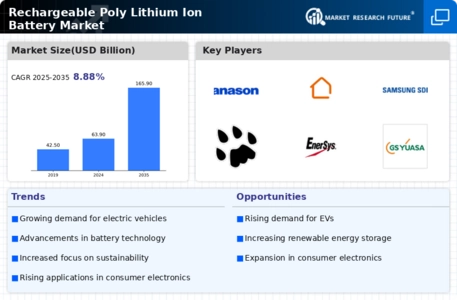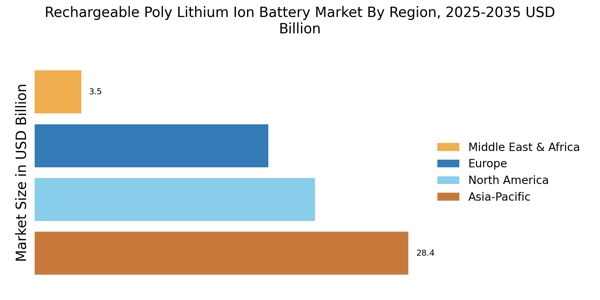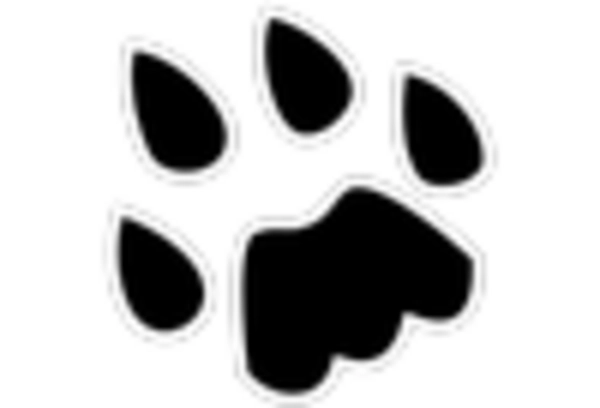Consumer Electronics Market Expansion
The Rechargeable Poly Lithium Ion Battery Market is experiencing growth due to the expansion of the consumer electronics market. With the increasing proliferation of portable devices such as smartphones, tablets, and laptops, the demand for efficient and long-lasting batteries is on the rise. Recent market analysis indicates that the consumer electronics sector is expected to grow at a CAGR of approximately 10% over the next few years, which will likely drive the demand for rechargeable poly lithium-ion batteries. As manufacturers seek to enhance battery life and performance, innovations in battery technology are becoming essential. This trend not only supports the growth of the Rechargeable Poly Lithium Ion Battery Market but also encourages further research and development in battery technologies, ensuring that consumer electronics continue to evolve.
Increased Demand in Electric Vehicles
The Rechargeable Poly Lithium Ion Battery Market is witnessing a surge in demand driven by the electric vehicle (EV) sector. As more consumers and manufacturers shift towards electric mobility, the need for efficient and reliable battery solutions is paramount. Recent statistics indicate that the EV market is expected to grow at a compound annual growth rate (CAGR) of over 20% in the coming years, significantly impacting the rechargeable battery market. This trend is further supported by government incentives and policies promoting electric vehicle adoption, which are likely to bolster the Rechargeable Poly Lithium Ion Battery Market. As automakers invest heavily in battery technology to enhance vehicle range and performance, the demand for high-capacity lithium-ion batteries is expected to rise, creating new opportunities for market players.
Growth in Renewable Energy Storage Solutions
The Rechargeable Poly Lithium Ion Battery Market is significantly influenced by the growth of renewable energy storage solutions. As the world transitions towards cleaner energy sources, the need for efficient energy storage systems becomes increasingly critical. Lithium-ion batteries are well-suited for storing energy generated from renewable sources such as solar and wind. Recent data suggests that the energy storage market is projected to reach a value of over 200 billion by 2030, with lithium-ion batteries playing a pivotal role. This growth is driven by the need for grid stability and the integration of renewable energy into existing infrastructures. Consequently, the Rechargeable Poly Lithium Ion Battery Market stands to benefit from this trend, as investments in energy storage technologies continue to rise.
Technological Advancements in Battery Technology
The Rechargeable Poly Lithium Ion Battery Market is experiencing rapid technological advancements that enhance battery performance and efficiency. Innovations such as solid-state batteries and improved electrolyte formulations are being developed, which could potentially increase energy density and reduce charging times. According to recent data, the energy density of lithium-ion batteries has improved by approximately 20% over the past few years, indicating a trend towards more efficient energy storage solutions. These advancements not only improve the overall performance of rechargeable batteries but also expand their applications across various sectors, including consumer electronics and renewable energy storage. As technology continues to evolve, the Rechargeable Poly Lithium Ion Battery Market is likely to witness increased investment and research, further driving growth.
Sustainability Initiatives and Environmental Concerns
The Rechargeable Poly Lithium Ion Battery Market is increasingly influenced by sustainability initiatives and growing environmental concerns. As governments and organizations worldwide emphasize the importance of reducing carbon footprints, the demand for eco-friendly energy storage solutions is rising. The production of lithium-ion batteries is becoming more sustainable, with efforts to recycle materials and reduce waste. For instance, the recycling rate of lithium-ion batteries is projected to reach 50% by 2030, which could significantly impact the market dynamics. This shift towards sustainability not only aligns with global environmental goals but also enhances the appeal of rechargeable poly lithium-ion batteries in various applications, including electric vehicles and renewable energy systems. Consequently, the Rechargeable Poly Lithium Ion Battery Market is likely to benefit from these initiatives, fostering growth and innovation.


















Leave a Comment